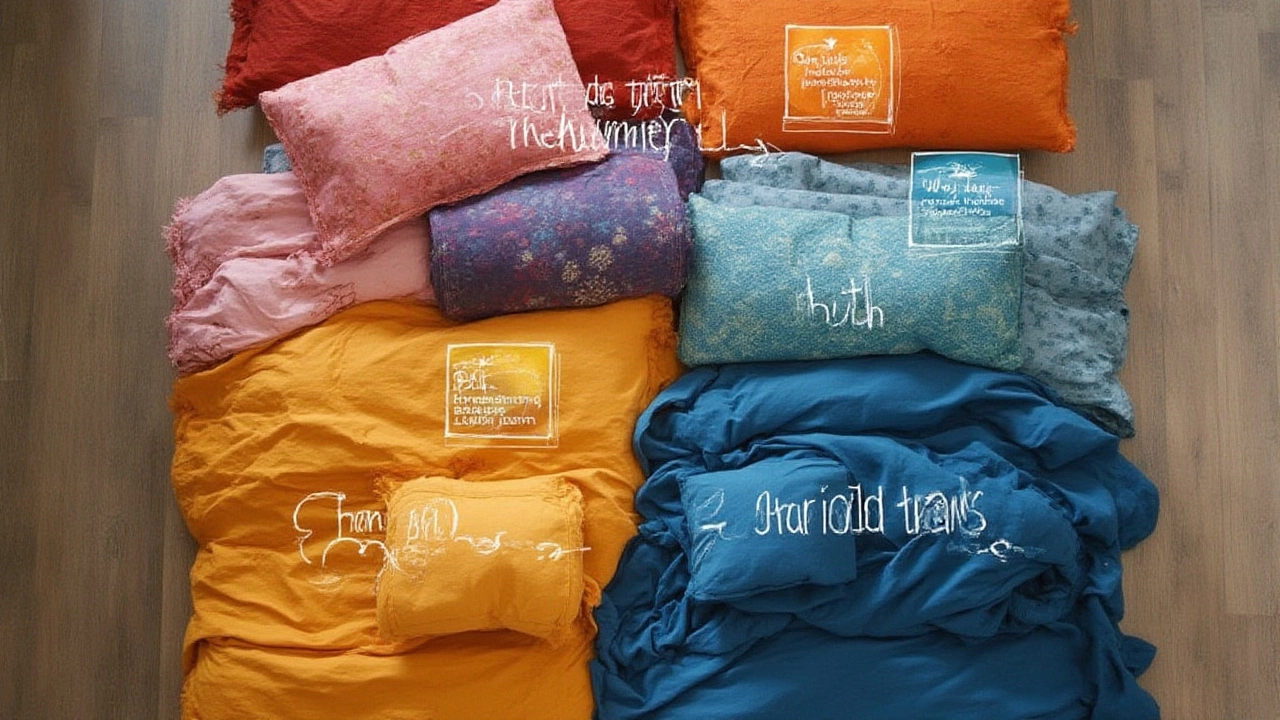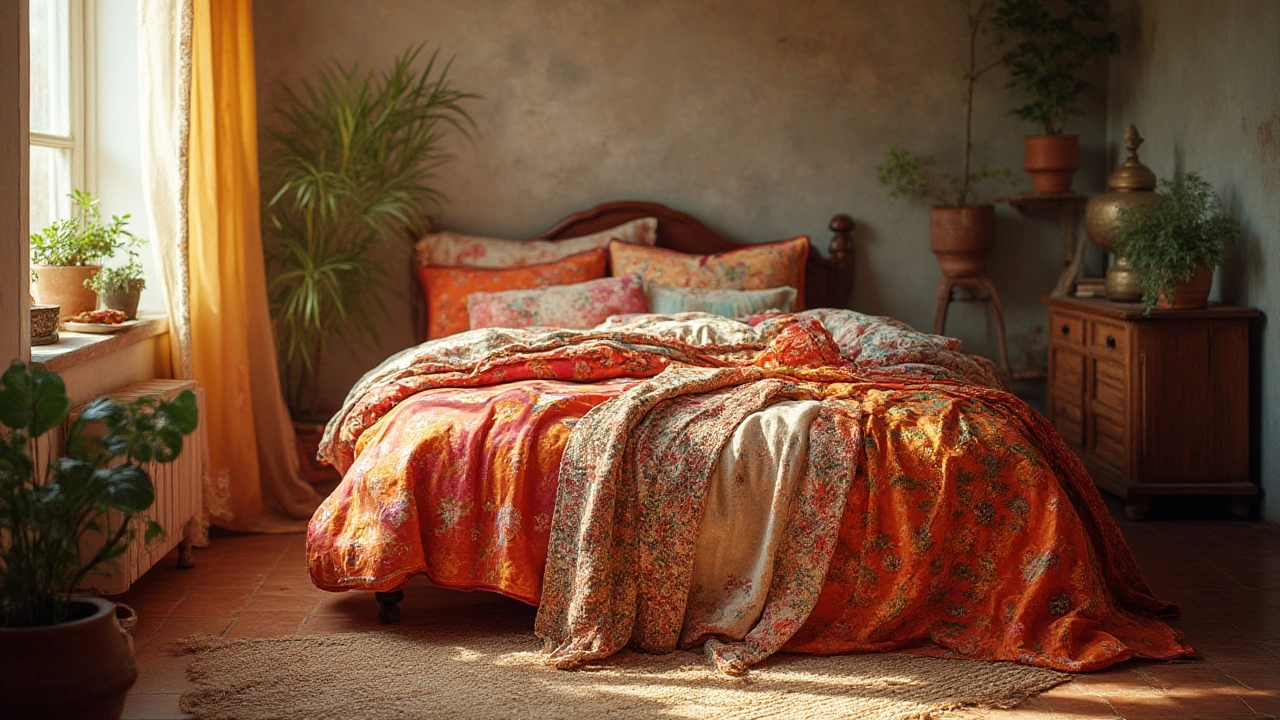You might think bedding is just sheets and blankets. But what actually counts as bedding? Turns out, this question gets surprisingly technical, with threads that wind through history, manufacturing, and even government regulations. It’s one of those household staples that everyone uses but almost nobody talks about in detail—and yet it touches your skin more than most things in your house. Ready to get comfortable and finally learn what bedding really means?
What Counts as Bedding?
Walk into any home goods store, and you’ll hear the word ‘bedding’ a hundred times before you hit the checkout. So what’s included? At its basic, bedding is everything that covers your mattress and helps you sleep. According to the Textile Industry Standards Association, bedding covers a variety of items designed to support sleep and improve hygiene. Here’s what actually makes the cut:
- Bed sheets: Both fitted sheets (that hug the mattress) and flat sheets (that lay on top).
- Pillowcases: Slip onto pillows to protect and add comfort.
- Duvet covers and comforters: These cover and insulate, sometimes working in tandem.
- Blankets and quilts: Quick warmth, seasonal layers, sometimes decorative.
- Mattress protectors and toppers: Defensive linemen for your mattress, helping with hygiene and lifespan.
Items like decorative pillows, throws, and bed skirts circle the edges of the category. Some industry groups count them under ‘home textiles’ instead, since they’re mostly for looks. Regulatory agencies like the U.S. Consumer Product Safety Commission officially group ‘bedding’ as bed linens and protective coverings for the mattress and pillows, largely because these are involved in product standards and safety recalls. So if you’re shopping based on official classifications, those silk firefly-pattern throw pillows? Not bedding. But your cozy flannel sheets and those slightly embarrassing dog-print pillowcases? Absolutely bedding.
The classification is not just a matter of shopping convenience. It decides which products are subject to labeling laws, flame retardant standards, and sometimes even import taxes. In the UK, for example, the British Standard 7175 spells out the fire standards for anything classed as bedding in hospitals and hotels—if it touches the sleeping surface, it's bedding. Weird detail, right?
What about those moments when industry definitions and popular usage don’t quite match? For example, a ‘bedspread’ might be called bedding at your favorite online store, but in a legal dispute about product recalls, only the sheets and pillowcases get counted. This confusion is why, when you see bedding sets advertised, they often include only the essentials: sheets, pillowcases, and—in bigger sets—a duvet cover or comforter. Always check what's in the box.

Bedding Types and Materials: What Sets Them Apart?
Once you get past the basics of what’s included, bedding gets much more interesting. The fabric you choose not only affects comfort but also care and even how long your bedding will last. The American Association of Textile Chemists and Colorists (AATCC) publishes tests for abrasion resistance and color fastness—key info if you want bedding that survives dozens of washes. Seriously, there’s science behind why that favorite cotton sheet finally gave up after only two years.
Here are the most popular materials, with some concrete details to compare:
- Cotton: The favorite for a reason. Breathable, absorbent, softens after washing. But quality varies wildly; the industry uses “thread count” (threads per square inch) to indicate density, though higher isn’t always better. Egyptian and Pima cotton are famous for durability and a smooth finish.
- Linen: Made from the flax plant, linen bedding is known for coolness and moisture-wicking. It wrinkles easily—some people love the casual look, others not so much. Usually pricier than cotton but can last decades.
- Polyester/Microfiber: Synthetics often cost less, and modern microfiber is surprisingly soft. Tends to hold color well, but may trap heat and doesn’t always breathe as naturally as cotton.
- Bamboo: Technically a form of rayon, but it’s gotten lots of love for being environmentally friendly (though the production process varies a lot). Feels silky, resists bad smells… but durability can be hit-or-miss depending on the weave.
- Silk: The ultimate in luxury. Hypoallergenic and helpful for people with sensitive skin or allergies. Requires delicate care. Most silk bedding is mulberry silk—stronger and smoother than wild silk. Watch out for imitations.
Bedding materials can even affect your health. Cotton and linen both score well for people prone to night sweats, since they wick moisture and allow airflow. On the other side, heavy-weight microfiber (polyester) can make you feel trapped in a heat bubble. As for allergies, wool and silk both naturally fight dust mites and mold—but, weirdly, wool often triggers allergies for some people.
Stats from the National Sleep Foundation say that over 46% of Americans change their bedding material by season; more than half use lighter cotton or linen in summer, switching to fleece or brushed microfiber in winter. Urban buyers go for hypoallergenic options at twice the rate of rural shoppers—likely because of the higher rates of dust mites and pollution in city homes.
Durability is another major concern. According to a study published in the International Journal of Consumer Studies (July 2022), cotton percale sheets outlast microfiber on abrasion tests by up to three years. Linen, when cared for properly, often lasts a decade or more. Poly-blends tend to pill but keep color longer, so they’re popular for kids’ bedding. Here’s a quick comparison in handy data form:
| Material | Average Lifespan | Comfort | Care Difficulty | Typical Price |
|---|---|---|---|---|
| Cotton (Percale/Sateen) | 3-5 years | Soft, breathable | Easy | $$ |
| Linen | 8-10 years | Cool, airy | Medium | $$$ |
| Polyester/Microfiber | 2-4 years | Smooth, warm | Very easy | $ |
| Bamboo/Rayon | 3-5 years | Silky, cool | Medium | $$ |
| Silk | 4-6 years | Luxury, cool | Difficult | $$$ |
Big-ticket hotel chains like Marriott and Hilton use high-density cotton percale or sateen because they last longer, resist stains, and give off that ‘crisp and fresh’ vibe. When you see ‘hotel sheets’ for sale, it’s usually code for heavy-duty, mostly-cotton sheets with reinforced seams.
If you want smarter code for sleep, here’s a pro tip: match your pillowcases and sheets in material and weave for comfort and less laundering hassle. If you use add-ons like mattress toppers or waterproof protectors (especially with kids or pets), make sure they’re machine washable and labeled “breathable” so you don’t end up sweating through the night.

How to Choose and Care for Bedding: Industry Tips and Little-Known Facts
Shopping for bedding can feel like walking through a maze of buzzwords—‘Egyptian cotton! 1000 thread count! Deep pocket fitted!’ If you want to actually make sense of it and not just fall for the marketing hype, it helps to understand what matters in quality and care. Several sleep experts agree: ‘More expensive’ isn’t always better, but investing in natural fibers and quality stitching usually pays off over time.
- Tip one: Check the label for material details. If it just says ‘cotton blend,’ you’re probably getting a lot of polyester. Look for ‘100% Egyptian cotton’ or ‘pure linen’ for top shelf.
- Tip two: Thread count is worth a glance, but don’t get sucked in. Above 400-500, you usually move from softer to stiffer, not softer to cloud-like. Instead, check weave type: percale for a cool matte finish, sateen for something sleeker.
- Tip three: If you have sensitive skin or allergies, always wash new bedding before use. Chemicals called ‘sizing’ used in manufacturing can irritate. Fragrance-free, hypoallergenic detergents are best.
- Tip four: Buy extra pillowcases. These wear out first—and they need more frequent washing because your face (and hair oils) are always there.
- Tip five: Rotate your bedding sets if you want them to last. Even two or three sets, swapped out weekly, cuts wear and keeps things fresh. The Global Hygiene Council found that households using multiple bedding sets reduced dust mite buildup by 60% compared to reusing the same set all month.
Got pets or kids? Waterproof mattress protectors save more beds than you’d think. And if you loathe ironing, pre-washed linen or jersey cotton sheets hide wrinkles naturally. Want color that lasts? Dark, high-quality cotton holds dye better — just wash in cold and dry on low to prevent fading.
Here’s another fact that gets overlooked: bedding influences your sleep quality. The National Institutes of Health published a study in 2024 showing temperature-regulating fabrics help people fall asleep 15% faster during summer nights, compared to standard polyester or poly-blend sheets. Night sweats? Go with linen, Tencel, or bamboo-derived sheets—they absorb moisture and dry out quickly.
Care is mostly common sense, but there are a few things people miss. Don't cram your washer full—bedding needs space to rinse and spin. Use gentle, liquid detergents (powders can leave residue) and avoid bleach if you want colors to last. Many pros recommend sun-drying bedding at least once a month as UV rays kill dust mites naturally without harsh chemicals. If you use a dryer, shake out sheets before tossing them in. Skip dryer sheets (they coat fabric), but wool dryer balls help sheets come out fluffy and less wrinkled.
Changing bedding regularly isn't just about feeling clean—it's about health. A 2023 survey by the Sleep Products Association revealed 31% of people wait three weeks or longer to wash bedding, but experts recommend at least once a week for pillowcases and sheets, especially if you have allergies or sweat at night. Keeping extra sets on hand makes laundry less of a chore.
As for storing out-of-season bedding, always pack in breathable cotton or linen storage bags—plastic traps moisture and encourages mildew. Cedar chips or lavender pouches add a fresh scent and can help keep pests away.
When shopping, don't let the fancy packaging or trendy colors distract you from comfort and care. In the end, good bedding gives you better sleep, supports hygiene, and lasts for years. So, next time you’re redoing your room, think beyond the pattern and focus on what will cradle you, night after night. Smart bedding choices pay off every time you slip between the sheets.
